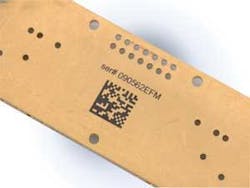Advanced software for fiber laser marking
by Bob Henry
A unique feature aids in the integration of part-marking equipment for today's manufacturers
Whether they are federally mandated or company-imposed, marking regulations are becoming far more stringent across the board. Aerospace, automotive, medical device design—these are just a handful of industries in which permanent marking has become an imperative activity in day-to-day manufacturing.
Laser marking equipment is used for a variety of purposes in a multitude of industries—it can help companies strengthen identification processes, improve quality control, increase traceability, and even assist with branding efforts. This article discusses industrial marking technologies and the unique feature of open-architecture software design that lets manufacturers integrate part marking into their business, allowing them to better handle the three most common metal marking applications.
Before selecting the right laser marking system, it's important to understand the differences between the two common types of laser marking systems: Nd:YAG and fiber laser systems and CO2 laser systems.
Industrial marking applications are, for the most part, performed on bare metals and engineered plastics using a Nd:YAG or fiber laser. The fiber laser is a fiber optic cable that has been doped with Ytterbium. By pumping the fiber optic cable with light to excite the Ytterbium, the optic cable is able to act as both the laser source and as the delivery system for the laser beam. A fiber laser emits a wavelength between 1055nm and 1070nm in the infrared range similar to Nd:YAG lasers. The high per-pulse energy of today's pulsed fiber laser systems and the much shorter wavelength is what makes marking on metal feasible.
CO2 laser engraving systems, while versatile, are not designed for high-quantity, continuous marking of bare metal. However these metals can be marked with a CO2 laser using a two-step metal marking process. Bare metals must first be treated with a metal marking material like Cermark or TherMark. The coated metal is then marked with the CO2 laser and the laser energy bonds the metal marking material to the metal, creating a permanent dark black mark. The excess solution is then wiped away with water. While the mark is permanent, the process can be too time-consuming for higher volume industrial applications, but does allow for low cost marking of parts in low to mid-volume production applications.
Understanding the differences between the two general types of laser systems will help manufacturers understand which type will help them better meet their marking needs.
While many manufacturers outsource their part-marking activities to machine shops or other service providers, many are realizing the value of bringing this necessary activity in-house. Outsourcing part-marking needs can be costly and time consuming. Although the idea of saving time and money are appealing in today's uncertain economy, manufacturers may not be aware that recent technological advancements have made fiber laser marking systems user-friendly and cost-effective. They also may be concerned with learning a new piece of equipment and the proprietary design software that comes along with it—especially if a company is already accustomed to using a different type of design software.
Most CO2 laser engraving systems use an open-architecture software design (meaning the computer “prints” to the laser using most any graphic design software) (see FIGURE 1). With these systems, users can import their artwork using almost any Windows-based design program, such as Adobe PhotoShop, CorelDRAW, AutoCAD, barcode/serialization software, and so on, and then send the job to the laser. While CO2 machines are capable of metal marking, the process can be challenging, especially when large material quantities are involved.
Fiber laser technology allows for permanent markings on a variety of bare metals and certain engineered plastics and ceramics. Advances in technology have made fiber laser marking systems easier and more practical to use. Today's fiber systems are, for the most part, controlled by proprietary design software and a PC, and the most challenging and time-consuming task is learning the proprietary design software that comes with it. Unlike CO2 laser engraving systems, where open-software compatibility is common, it's a unique characteristic among fiber laser systems. The majority of fiber laser manufacturers require the use of proprietary software to effectively run the equipment.
Operating fiber laser systems is relatively easy; however, learning the proprietary software used to control the systems, as well as training others to use it, can be daunting. Systems with an open-architecture design greatly simplify the process because employees can use design software with which they're already familiar, making system integration a much smoother and more streamlined process. Time spent training is time not spent on normal business activities. Productivity temporarily decreases. Increase the number of employees being trained and lost work time also increases. This pattern will repeat each time a new employee is hired and trained.
In regard to metal marking, there are many different applications or finished “looks” fiber laser systems were designed to achieve. These looks are all created using various speed, power, and frequency settings of the fiber laser system. Having an open-architecture laser system allows manufacturers to quickly create the mark they need because they're using software already familiar to them.
Etching is often used for industrial purposes, such as for marking tools or parts with serial numbers, logos, and barcodes (see FIGURE 2). The etching process actually removes small amounts of material from the metal piece to create whatever mark the user desires (barcode, data matrix code, etc.). Essentially, it is a very shallow engraving that produces a high contrast mark in the metal.
Polished metal, or “mirrored” as it is sometimes called, is a laser effect where the laser beam heats the surface of a material and as it cools, the material takes on a different finish. Most common on matte-finish metal, this technique creates marks that can look almost holographic. Unlike etching, no material is actually removed from the metal being marked as the heat alters the finish of the metal. Because the polished look emits a sense of sophistication and distinction, it is often used in architectural signage and labeling high-end products where a unique or aesthetically pleasing mark is necessary. The mirrored finish produces a tone-on-tone look where the metal has been marked.
The annealing process is similar to the polishing process. The laser is used to heat metal to near melting points, which induces a color change to the top layer of material. Annealing often gives a dark iridescent look, with a faint rainbow of greens, blues, and pinks that can sometimes be seen in the text or graphic. Because no material is removed from the metal, this technique is often used for medical devices used within the human body. Annealing leaves no cuts or shallow engravings like those found in marking and etching and typically produces the darkest mark of these three methods.
While these common applications can be performed by a variety of fiber laser systems, the few systems with open-architecture software capabilities are the ones that will allow manufacturers to make the switch much less disruptive to employees and production.
Regardless of the specific application, manufacturers are increasingly recognizing the value of bringing part marking in-house. Whether they are looking to reduce outsourcing costs or make the process more time-efficient, selecting a marking system with open-architecture software design will no doubt make it a much easier task.
Bob Henry is FiberMark product manager at Epilog Laser, Golden, CO, www.EpilogLaser.com.


